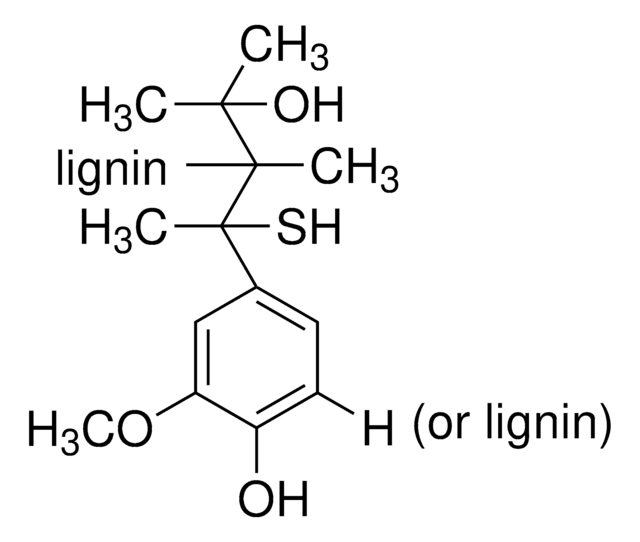추천 제품
일반 설명
Beechwood creosote is a colorless to yellowish greasy liquid obtained from the distillation of wood tar. It comprises of phenol, 4-methylphenol, 2-methoxyphenol, and 2-methoxy-4-methylphenol as its major volatile constituents.
애플리케이션
Creosote from beechwood tar has been used as raw material in the synthesis of phenolic branched-chain fatty acids (n-PBC-FA) in the presence of a modified H+ Ferrierite zeolite catalyst.
생화학적/생리학적 작용
Creosote from beechwood tar has been reported to exhibit antioxidant activity comparable to that of popular antioxidants α-tocopherol and butylated hydroxytoluene (BHT). It is used as a herbal antidiarrheal medicine owing to its antisecretory activity. Beechwood creosote has also been found to show bactericidal, fungicidal and laxative action.
신호어
Danger
유해 및 위험 성명서
Hazard Classifications
Acute Tox. 3 Dermal - Acute Tox. 3 Oral - Acute Tox. 4 Inhalation - Aquatic Chronic 2 - Eye Dam. 1 - Muta. 2 - Skin Corr. 1A - STOT RE 2
표적 기관
Nervous system,Kidney,Liver,Skin
Storage Class Code
6.1A - Combustible acute toxic Cat. 1 and 2 / very toxic hazardous materials
WGK
WGK 3
Flash Point (°F)
165.2 °F - closed cup
Flash Point (°C)
74 °C - closed cup
개인 보호 장비
Faceshields, Gloves, Goggles, type ABEK (EN14387) respirator filter
가장 최신 버전 중 하나를 선택하세요:
Korean Beechwood Creosote as a Substitute to an Antibiotic for Post Weaning Diarrhea in Piglets.
Sodhi S, et al.,
Pakistan Veterinary Journal, 34(3) (2014)
Bio-based phenolic-branched-chain fatty acid isomers synthesized from vegetable oils and natural monophenols using modified H+-Ferrierite zeolite
Yan Z, et al.,
Industrial Crops and Products, 114 (2018)
Nobuaki Moriguchi et al.
Yakushigaku zasshi, 46(1), 13-20 (2011-12-15)
Wood creosote is a medicine that has been listed in the Japanese Pharmacopoeia (JP) since the first edition published in 1886. Medicines containing wood creosote and other natural ingredients have been very popular in Japan and Southeast Asian countries. In
Jenny Hultgren et al.
International journal of phytoremediation, 12(1), 54-66 (2010-08-26)
The degradation of polyaromatic hydrocarbons (PAH) in an aged creosote-contaminated soil in the presence of Salix viminalis was investigated in a greenhouse experiment. Phenanthrene and pyrene were degraded 100% and 80%, respectively, in the presence of plants but only 68%
Mari Nyyssönen et al.
Applied microbiology and biotechnology, 84(1), 169-182 (2009-05-22)
A small-scale functional gene array containing 15 functional gene probes targeting aliphatic and aromatic hydrocarbon biodegradation pathways was used to investigate the effect of a pilot-scale air sparging and nutrient infiltration treatment on hydrocarbon biodegradation in creosote-contaminated groundwater. Genes involved
자사의 과학자팀은 생명 과학, 재료 과학, 화학 합성, 크로마토그래피, 분석 및 기타 많은 영역을 포함한 모든 과학 분야에 경험이 있습니다..
고객지원팀으로 연락바랍니다.











